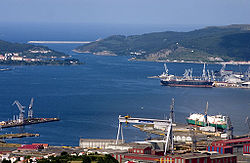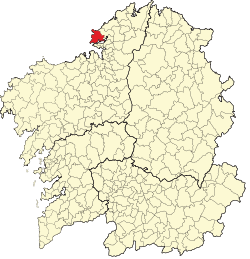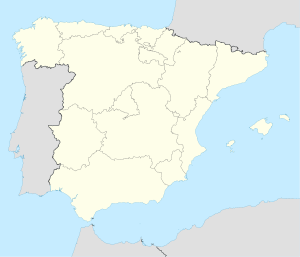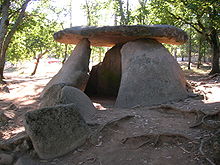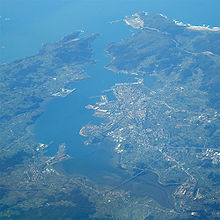- Ferrol, Galicia
-
Ferrol
El Ferrol— City — 
Flag
Coat of armsLocation of the municipality of Ferrol within Galicia Location of Ferrol within Spain. Coordinates: 43°28′N 8°15′W / 43.467°N 8.25°WCoordinates: 43°28′N 8°15′W / 43.467°N 8.25°W Country Spain Region Galicia Province A Coruña County Ferrol Fishing Village 1st century BC Christian Outpost 8th century Royal Arsenal 16th century Royal Dockyard 18th century Parishes Brión, A Cabana, Covas, Doniños, Esmelle, Ferrol, A Graña, Leixa, Mandiá, Marmancón, A Mariña, Trasancos, Serantes Government – Type Mayor-council – Body Concello de Ferrol – Mayor Vicente Irisarri Castro (PSdeG) Area – Total 81.9 km2 (31.6 sq mi) Population (2009)INE – Total 74,273 Demonym ferrolan (m), ferrolana (f) Time zone CET (GMT +1) – Summer (DST) CEST (GMT +2) (UTC) Postcode 15401 - 15406 Area code(s) +34 981 Website http://www.ferrol.es/ Ferrol or El Ferrol is a city in the province of A Coruña in Galicia, located on the Atlantic coast in north-western Spain. As of 2007[update], it has an urban population of 77,859 and a metropolitan area population of over 241,528.
The city has been a major naval shipbuilding centre for most of its history, being the capital of the Spanish Navy's Maritime Department of the North since the time of the early Bourbons. Before that, in the 17th century, Ferrol was the most important arsenal in Europe. Today, the city is also known as the home of the shipbuilding yards of Navantia.[1]
The city was the birthplace of the Spanish General Francisco Franco in 1892, and was officially known as El Ferrol del Caudillo from 1938 to 1982. It was also the birth place of the founder of the Spanish Socialist Workers' Party (PSOE), Pablo Iglesias, in 1850.
Contents
History
The existence of prehistoric human settlements in this green corner of Iberia is backed up by the abundance of burial chambers, megalithic monuments as well as Petroglyphs and other archaeological findings. The Phoenicians established in this area different dried and salted cod stations and their presence together with the presence of the Ancient Greeks is well documented by historians like Herodotus amongst others. In Roman times, in the 1st century BC, a fishing port existed in the bay of Ferrol. After the fall of the Western Roman Empire the whole Iberian Peninsula, including Ferrol, was raided by the Vandals and occupied in 411 by the Suebi; their kingdom was incorporated in 584 by Leovigild to the Visigothic kingdom of Spain.[2]
Raided from 711 to 739 by the Arabs, Ferrol was ultimately recaptured by the Visigothic king of Asturias in 754 remaining onwards an integral part of Christian Spain.[3]
The House of Asturias established an important Christian Outpost to protect their realms from the Arab invaders. In the 14th century Henry II gave the town to the powerful Andrade family.[4]
In 1568[5] a fire reduced to rubble the old medieval town; in the same period some parts of the existing fortifications at the entrance of the estuary were built.[6] As a naval base, at that time the town was considered more important as a Royal Arsenal than as a safe harbour.
With the arrival of the Bourbons in the 18th century, Ferrol became a leading naval centre.[7] Ferrol was made Capital of the Maritime Department of the North, formed under Ferdinand VI and Charles III for the defence of the Spanish Colonial Empire in America. Rapid improvements followed, notably under the leadership of the Marquis of Ensenada, and the position of Ferrol was made almost unassailable from the sea, the difficulties of disembarking troops on its precipitous coast being strengthened by a renewed line of fortresses and newly built castles, including that of San Carlos.
The Royal Dockyards of A Graña and Ferrol, built between 1726–1783,[8] produced ships protected with copper sheets from the rolling mills of Xubia. In 1772, The Spanish Royal Academy of Naval Engineers of Ferrol, the first such academy in Spain, was created.
Ferrol was virtually impossible to blockade in the age of sail, as strong westerly winds would take any blockading force away along the treacherous north coast of Spain where they had no safe haven. The geography of Ferrol meant that an entire Spanish fleet could slip out on a single tide. By the time the British were able to resume the blockade, the Spanish would be safely away and out to sea. Despite these advantages, a decline set during the reign of Charles IV, and in 1800, after the defences had been reduced, a British fleet of 109 vessels landed troops on the beach of Doniños to take the Castle of San Felipe. Although only equipped with meagre artillery, the castle's small defence force under the command of Count Donadio together with a sizable number of volunteer citizens of Ferrol, successfully resisted the attack and the fleet withdrew. The alliance with the United Kingdom during the Peninsular War of 1808-14 failed to prevent the deterioration in the town’s fortunes. The arsenals and fortresses were abandoned and they were easily occupied by the French in 1809.
Under Ferdinand VII, Ferrol lost its title of capital. New activities sprang up, however, in the mid-19th century, during the administration of the Marquis de Molina,[9] Spanish Minister for Naval affairs, which included amongst other political successes the construction and launch in the Royal Dockyards of Ferrol of Spain's first steam propelled ship in 1858.
The second half of the 19th century brought to the Royal Dockyards of Ferrol not just plenty of work but social and political tensions which ended up in the failed republican uprising of 1872.[10]
Ten years after the Spanish-American War of 1898,[11][12] in which Spain lost Cuba and the Philippines, the Antonio Maura Government, in an attempt to restore the Spanish Navy and Spanish shipbuilding industry hired the Spanish Society for Naval Construction, whose major investors were the British firms John Brown, Vickers and Armstrong[13] the shipbuilding yards, workshops, foundries and dry docks in Ferrol.
For a period of sixteen years, all the technicians were exclusively British, and the situation was not altered till 1925 when the management was taken over by Spanish engineers, as one of the new policies introduced by the then newly created government, including ministers both civil and military, of the dictator Miguel Primo de Rivera (1923–1930). The arrival of the British coincided with the construction of a local electric-powered trolley streetcar’s line (1924–1961).[14]
In sight of the outbreak of the Spanish Civil War, and because there was fear of social unrest in the naval station, the Foreign Office in London,[15][16] organized a ship to repatriate all the remaining British citizens and on 22 July 1936 HMS Witch (D89)[17] departed from Ferrol back to Britain. At the outbreak of the Spanish Civil War (1936–1939) the shipbuilding yards, workshops, foundries and dry docks in Ferrol were taken over by the state and fully nationalized in 1945 under the name "Bazàn", later renamed "IZAR", and, starting from January 2005, Navantia. The town was the birthplace of dictator Francisco Franco, after whom the city was officially known as El Ferrol del Caudillo from 1938 to 1982. The end of the dictatorship and the arrival of democracy in 1978 did not help Ferrol,[18][19] and from 1982 to the early 1990s, the city confronted numerous problems due to a decline in the naval sector. The beginning of the new millennium however has been a time of economic expansion and prosperity in general.[20] A new motorway and an outer-port[21] have been built.
Ferrol hosted the large NATO Maritime Exercise Loyal Mariner (RN) in June 2008.[22]
Climate
Climate data for Ferrol, Spain Month Jan Feb Mar Apr May Jun Jul Aug Sep Oct Nov Dec Year Average high °C (°F) 13
(56)14
(57)15
(60)16
(61)18
(64)20
(69)22
(71)23
(73)22
(71)19
(66)16
(60)14
(57)17
(59)Average low °C (°F) 9
(47)9
(47)10
(49)10
(50)12
(54)14
(58)16
(61)16
(62)16
(60)13
(56)11
(52)10
(49)10
(53)Precipitation cm (inches) 8.38
(3.3)5.61
(2.21)5.18
(2.04)6.98
(2.75)5.1
(2.01)3.08
(1.21)2.37
(0.93)2.79
(1.1)4.82
(1.9)10.36
(4.08)9.95
(3.92)8.32
(3.28)72.94
(28.73)Source: MSN Weather[23] Economy
Primary Industries include horse breeding, fish farming and fishing (specializing in the Atlantic shoals), mining (ENDESA), non-timber forest products, quarries and timber. Secondary Industries include shipbuilding, ship engines, wind turbines, electrical equipment, ironworks, Textiles, food (canned fish) and wood-made products.
Tertiary activities include mercantile, fishing and military ports, restaurants, media, hotels and tourism.
Sister cities
These are the official sister cities of Ferrol:
Notable people
- Alonso Pita da Veiga
- Benito Vicetto Pérez (1824–1878), writer
- Jenaro Pérez Villaamil (1807–1854), painter
- Concepción Arenal (1820–1893), feminist activist
- José Canalejas Méndez (1854–1912), former Spanish Prime Minister died in office
- Patricio Montojo y Pasarón (1839–1917), admiral
- Pablo Iglesias Posse (1850–1925), politician
- Marquis of Amboage (1823–1892), multimillionaire and politician
- Frederick H. Shaw (1864–1924)
- Fernando Álvarez de Sotomayor y Zaragoza (1875–1960), painter
- Ramón Franco (1896–1938), aviator
- General Francisco Franco (1892–1975), ruled Spain as dictator after the Spanish Civil War (1936–1939).
- Ricardo Carvalho Calero, first ever professor of Galician literature and Linguistics - University of Santiago de Compostela (1910–1990)
- Gonzalo Torrente Ballester (1910–1999), writer
- Ángeles Alvariño Gozález (1916–2005), biologist and oceanographer (1916–2005)
- María Isabel Rivera Torres (born 1952), actress
- Jesús Vázquez Martínez (born 1965), TV presenter
- Paloma Pérez-Lago González (born 1967), one fashion model and TV presenter
- Carlos Jean (born 1973), electronic musician and music producer
- Paula Vázquez Picallo (born 1973), TV presenter and model
- Ignacio Javier Gómez Novo (born 1979), professional footballer
See also
- Sociedad Española de Construcción Naval
- School of Peritos Navales and Industriales
- Endesa Termic
- Racing Club de Ferrol
- El Correo Gallego
- El Ferrol Diario
- El Diario de Ferrol
- El Casino de Ferrol
- El Circulo Mercantil de Ferrol
- El Club Naval de Ferrol
Notes
- ^ Navantia Navantia - Spanish Company, Leader in Military Shipbuilding
- ^ (Britoniensis ecclesiae episcopus) Mailoc or Maeloc was the bishop of Britonia who participated in the Second Council of Braga (572)
- ^ Official Web-site of the Diocese of Ferrol-Mondoñedo (Spanish)
- ^ Ferrol Naval 1750 Ferrol Historia - Interesting document showing the royals of Spain from 1492 till 1805: Spanish Empire
- ^ “History of Ferrol” El Ferrolano Newspaper, 10 February 1846, no.1, Front Cover: Ferrol
- ^ World Heritage List: El Ferrol (Submission Papers) UNESCO, 27 April 2007
- ^ The City and Naval Station of El Ferrol during the Reign of Charles III of Spain by the Dutch pilot Hugh Debbieg (1731-1810)
- ^ "Ferrol" Encyclopædia Britannica, 2009
- ^ "The Armies of Europe, Spain as a War Making Power" New York Times, 6 February 1858, Page 4
- ^ "Entrance into Ferrol of the Government Troops" New York Times, 16 October 1872, Page 1
- ^ "Great Activity at Ferrol" New York Times, 11 June 1898, Page 1
- ^ The launch of “Cardenal Cisneros” the first “Pre-dreadnought battleship” built in Ferrol, Spain (1897) "The Ferrol and the Galician-rias commercial-role with North, South and Central America":El Correo Gallego (Spanish Newspaper) 19th March 1897 by Jose R. de Trujillo, Spanish Royal Navy Commander (Spanish)
- ^ "SPANISH NAVY: Huge Contract in British Hands" Manchester Guardian, 1 February 1909, Page 12
- ^ Vistas y curiosidades sobre la historia de El Ferrol y España Amazing Charley Inc.
- ^ "British Vice-Consulate at Ferrol" General Correspondence FO 63/1041, The National Archives
- ^ "British Vice-Consulate at Ferrol" General Correspondence FO 72/1689, The National Archives
- ^ "British Sending Troops" New York Times, 22 July 1936, Page 3
- ^ Shipbuilding Ferrol Historia - Shipbuilding crisis crisis after the arrival of democracy in Spain
- ^ Spanish shipyard resists that sinking feeling Financial Times, 19 Octuber 1984
- ^ Fridtjof Nansen class frigates during one of the final stages for completion in Ferrol Ferrol Historia
- ^ Views of the new outer-port of Ferrol, an intermodal freight transport port design to suit the new needs Ferrol Historis
- ^ NATO Maritime Exercise Loyal Mariner (RN)
- ^ "Ferrol, ESP". http://weather.uk.msn.com/monthly_averages.aspx?&wealocations=wc%3a9979&setunit=F.
References
 This article incorporates text from a publication now in the public domain: Chisholm, Hugh, ed (1911). Encyclopædia Britannica (11th ed.). Cambridge University Press.
This article incorporates text from a publication now in the public domain: Chisholm, Hugh, ed (1911). Encyclopædia Britannica (11th ed.). Cambridge University Press.
External links
- Official website (Spanish) (Galician)
- Green Tourism in Northern Spain 2005
- Site devoted to the art of landscape and nature of Ferrolterra (Spanish)
Ferrol 
Eume Ortegal Ancient lands of the Counts of Andrade and Vilalba in the 14th century Abadín · Alfoz · Ares · Barreiros · Burela · Cabanas · A Capela · Cariño · Cedeira · Cerdido · Cervo · Cospeito · Fene · Ferrol · Foz · Guitiriz · Lourenzá · Mañón · Moeche · Mondoñedo · Monfero · Mugardos · Muras · Narón · Neda · Ourol · Ortigueira · A Pastoriza · Pontedeume · A Pontenova · As Pontes de García Rodríguez · Ribadeo · Riotorto · San Sadurniño · As Somozas · Trabada · O Valadouro · Valdoviño · O Vicedo · Vilalba · Vilarmaior · Viveiro · Xermade · XovePorts and lighthouses under the Authority of Ferrol-San Cibrao Port of San Cibrao with four Lighthouses · Port of Alumina Espanola with six Lighthouses · Roncadoira Point with one Lighthouse · Ria and Port of Vivero with seven Lighthouses · Port of O Barqueiro with five Lighthouses · Estaca de Bares Point with one Lighthouse · Santa Marta's Cove and the Ports of Espasante and Carino with four Lighthouses · Candelaria Point with one Lighthouse · Port of Cedeira with four Lighthouses · A Frouxeira Point with one Lighthouse · Cape Prior with two Lighthouses · Ria of Ferrol and the Ports of Ferrol Outer-port, A Graña, Mugardos and Ferrol Inner-port with twenty three Lighthouses
Cities in Galicia  Categories:
Categories:- Municipalities in A Coruña
- Port cities and towns in Spain
Wikimedia Foundation. 2010.

